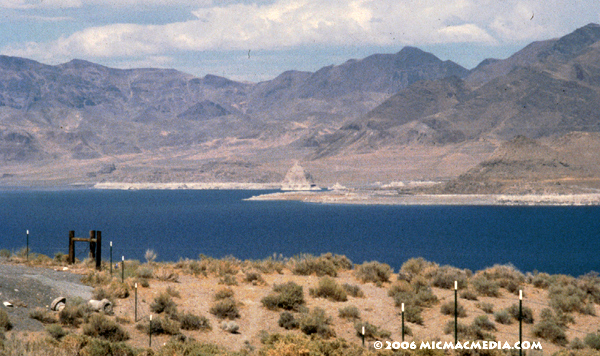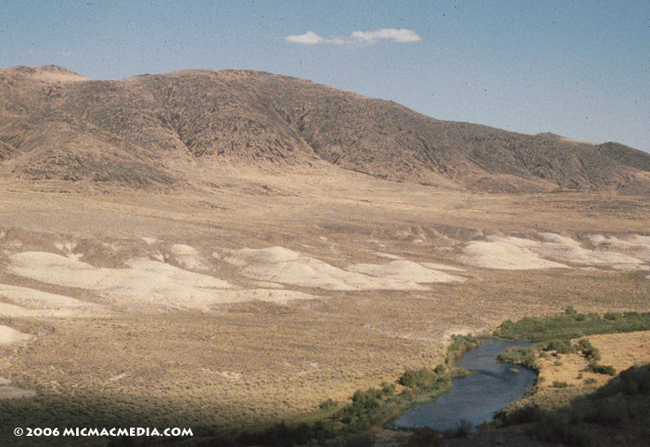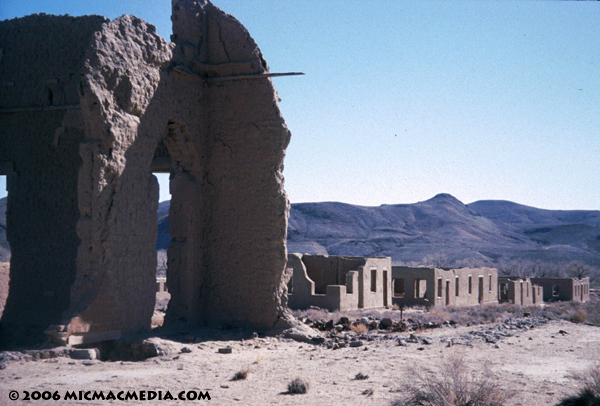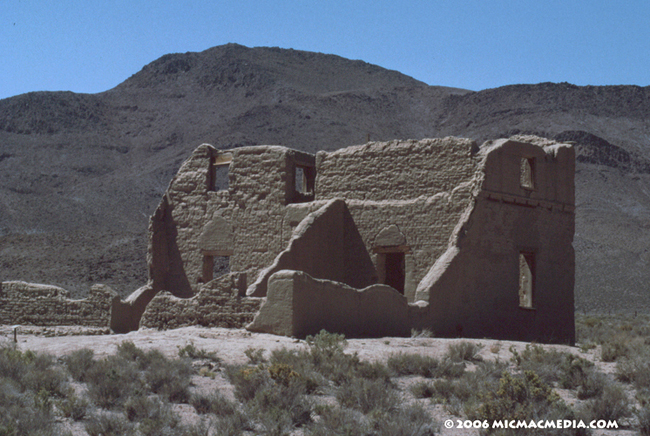|
Tahoe Nugget #80:
Battle at Pyramid Lake
May 31, 2006
In 1858, the Paiute Indians of present-day northern Nevada were in the midst of a war council. The young braves were furious. White miners and settlers were encroaching on the sacred ancestral lands around Pyramid
Lake, terminus of the Truckee River. The intruders were killing the game and cutting down trees from which the Indians harvested pine nuts, an important staple of their diet.
That very year, Indian agent
Frederick Dodge had sent a report to Washington, D.C. "…the game is gone, and now, the steady tread of the white man is upon them, the green valleys too, once spotted with game are not theirs now, necessity
makes them barter the virtue of their companions…Driven by destitution they seek refuge in crime."
For a time, strong leadership in the Paiute Nation kept the angry braves in check, but after the severe
winter of 1859-60, the tribe was facing starvation. In May 1860, the various tribal sects from western Nevada were calling for action against the white invaders. Old Winnemucca, son of Chief Truckee and a leader of
the Paiutes, kept his silence. The shrewd chief was willing to let the younger men assume responsibility for this war.
Winnemucca was resigned to living with the white man and counseled peace. (His father,
Truckee, had always been on friendly turns with the pioneers that were settling the west, but the increasing population was now squeezing the Indians out.) Only the brave warrior Numaga foresaw the disaster looming
for his people. Numaga dressed in the white man's clothing and had little authority, but he possessed a keen intellect and determined courage. He told the tribal leaders, "Your enemies are like sands in the bed of
the rivers; when taken away they only give place for more to come and settle."
Numaga's sage advice was always met by a cold stony silence. One chief came to him and said, "Your skin is red, but your heart
is white; go away and live among the palefaces." That evening an Indian riding a foam-flecked pony dashed into the council to inform the chiefs that a group of angry braves had burned Williams Station and killed
several settlers. The bold attack occurred because the white men at the station had kidnapped two twelve-year-old Indian girls and had held them bound and gagged in a secret cellar underneath the station house. When
the Indians found out, they rescued the girls, killed the men and set fire to the station. At the news, the prescient Numaga solemnly stared in the direction of Williams Station and said, "There is no longer any use
for counsel; we must prepare for war, for the soldiers will now come here and fight us."
At about the same time In Virginia City, a breathless rider stormed in from the darkness. It was James Williams, one of
the owners of the burned out trading post. Williams had survived the attack because he was away when it occurred, but his two brothers were among those killed. The horrifying news alarmed the populace. There were
small isolated groups of prospectors and ranchers scattered throughout northern Nevada and the Sierra east slope. They must be protected. Excitement ran high and men began calling for revenge; "the savages must be
punished." In the saloons that night, hundreds of rowdy young men strutting with the reckless courage that comes with drinking alcohol declared their intent to ride out in the morning to take the fight to the
Indians.
Bold boasts were made over brimming beer mugs; "…an Injun for breakfast and his pony to ride." It had been a long, cold winter; the miners were restless. Panic spread quickly over the
telegraph wires and men in Truckee, Carson City, and Genoa were called to arms. But at sunrise the next day, only 105 men showed up for the battle. The rest had fled to California or prudently declined to join in
the rash action. The military squads were a sloppy mixture of independent elements, poorly armed, and lacking discipline and training. They still believed that the battle against the Pyramid Lake Indians would be
easy, that the Indians would not fight. After all, the western Nevada tribes had generally been friendly to the whites.
The reckless volunteers gathered quickly from communities throughout the region.
Captain Alanson Nightingill led the Truckee Rangers; J. Reed headed the Sierra Guards. The Virginia Rifles and the Highland Rangers joined these squads. John "Snowshoe" Thompson was there, mustering with the Genoa
Rangers. The Carson City squad was led by Major William Ormsby, who would later die in the skirmish. Captain R. Watkins, a veteran of a recent military excursion into Nicaragua where he had lost a leg, was tied to a
saddle so he could once again ride into battle.
On May 12, 1860, this rag tag military outfit advanced into the desert toward Pyramid Lake, terminus of the Truckee River. They met no resistance until they
drew within two miles of the southern end of Pyramid Lake. At that point, a band of 150 Paiute warriors suddenly appeared on an elevated plain, just out of gunshot range. Most of the white men were armed with
revolvers and shotguns, poor weapons for distance and accuracy. One volunteer who possessed a telescopic rifle was ordered to fire. The Paiutes answered back with a barrage of whistling bullets. Major Ormsby told
the men to tighten the girths of their saddles; they were going to war. Moments later, the major gave the order to charge. It was a rash decision and fatal miscalculation.
Thirty men dashed up an easy grade
onto the plateau, but the Indians had disappeared. The vast landscape of sand and sagebrush seemed empty. Just then more mounted warriors were sighted, once again out of revolver or shotgun range. Slowly the
soldiers noticed that there were more braves positioned to the east and south in a half circle. They suddenly realized that they had charged right into a trap and were now surrounded by hundreds of mounted Paiutes.
More armed warriors appeared from behind the sagebrush surrounding the confused soldiers and then a hail of deadly Paiute arrows and bullets ripped through the air. The frightened horses began bucking under the
soldiers, forcing them to drop their guns into order to control their mounts.
All of the men had heard stories of what happened to white men captured by Indians. The tales were chilling. Fear swept through
the regiment and they broke into a run for the protection of a small grove of cottonwood trees bordering the Truckee River. It was their only chance to survive.
The vigilantes, poorly equipped and badly
organized, beat a hasty retreat, but instead of finding safety in the trees and brush along the river banks, the woods were swarming with warriors led by young Chiquito Winnemucca. As Chiquito and his band readied
to charge the settlers, the warrior Numaga, who had counseled peace and patience among his tribe, rushed to halt the final attack. Unfortunately, his last attempt at a peace parley came too late; Chiquito and his
braves rushed past Numaga and routed the terrified regiment.
What had begun as an orderly retreat became a wild, panic-stricken stampede. Where the trail narrowed and climbed a steep bank, the fleeing
soldiers on horseback stalled. Chiquito and his warriors cut eight men down before the others escaped. The trail then ran out into open desert country, straight and level. The fastest horses led the retreat. The
saddleless Indian ponies ran like the wind, enabling the pursuing Paiutes to take down the fleeing soldiers one by one.
The Indians chased the volunteers for twenty miles, killing as many as they could. Of
the 105 white men who went into battle at Pyramid Lake, 76 died and several were wounded. The Paiutes later claimed that, "had the battle opened two hours earlier in the day there would not have been one white
survivor." They were probably right. It was only by the cover of darkness that any of the volunteers escaped.
For three days no news reached the communities of western Nevada regarding the fate of the
reckless men who had rushed out to do battle with the Paiute Nation. Every night Indian signal fires were seen glowing on the distant ridges, but not one word from any of the missing men reached the settlements. The
desert's silence was an ominous omen. Finally, on May 13, an exhausted rider tore into town. The man had ridden all night, nearly 100 miles. He was covered with alkali dust and bore bad news. The Indians had slain
Major Ormsby and nearly wiped out the command. The Paiutes had trapped the soldiers like rats and killed nearly three-fourths of them. The shocked citizens figured the man was hysterical.
Throughout the
night and following morning, survivors from the battle slowly straggled in. The men told tales of horror and of a fate worse than death. One refugee claimed that he had seen thousands of mounted warriors headed for
the settlements. It seemed that the Indians had resolved to take back their country. Panic swept the Comstock and eastern Sierra. Martial law was declared in Virginia City. The town's few women and children were
moved into an unfinished stone house that had been converted into a fortress called Fort Riley. Citizens organized an armed militia and picket guards were posted on the city's perimeter. At Carson City, the Penrod
Hotel was barricaded with wood; and sentries were stationed around town.
News of the massacre spread like wildfire and Californians organized at once. Citizens in Sacramento and Placerville contributed money
to raise militias. Downieville residents were furious to hear that Henry Meredith, a well-liked local, had died in the fight. To avenge his death, they recruited, armed and equipped 165 men in just 36 hours. This
volunteer regiment, known as the Sierra Battalion, marched from Downieville over snow-covered Donner Pass to Virginia City in just five days. Miners from La Porte and farmers from Placerville also crossed the icy
mountain range to join the expanding army. San Francisco sent money and arms, as well as the 6th Infantry from the Presidio and the 3rd Artillery command from Benicia. California Governor John Downey issued 500 muskets with plenty of ammunition for Nevada's defense.
On May 31, 1860, more than 1,000 well-armed troops and volunteers marched back towards Pyramid Lake seeking revenge. The soldiers slowly made their way along the Truckee River, cautious of attack. On June 2, two feet of snow fell on the Sierra and the weather in the desert was cold and blustery. That afternoon, 300 Paiute warriors on horseback and 300 armed braves on foot attacked the regiments.
Instead of one large battle, there were many separate skirmishes as the outgunned Indians slowly retreated toward their villages at Pyramid Lake. There were numerous casualties on both sides. Forty-eight hours later, the American troops closed in on the Paiute settlement near the lake. The village was deserted. A distinct trail revealed that the Indians had fled into the Black Rock Desert. At that point the whites declared victory and withdrew. The Paiutes were a bold and fearless tribe when protecting their ancestral homeland, but their warriors could not compete with the overwhelming firepower brought to bear by the determined soldiers.
An uneasy peace was secured; Fort Churchill was built on the Carson River and Indian reservations were established at Pyramid and Walker lakes. The white man was here to stay, and the Paiutes' way of life would never be the same.
Photo #1: Topographical Engineer John Frémont named Pyramid Lake for the pyramid-shaped tufa formation on its eastern shore.
Photo #2: Tree-lined Truckee River offered no safety for the panicked pioneers.
Photo #3: Fort Churchill was abandoned in May 1869. This arid area 40 miles east of Carson City averages less than 5 inches of precipitation per year. Lumber was brought in from the Sierra and the windows and hardware shipped in from San Francisco.
Photo #4: Named in honor of General Sylvester Churchill, Inspector General of the U.S. Army, the fort is located near the Carson River which provided water. Since it was on the Pony Express route the troops enjoyed regular mail and newspaper service. Although the fort was considered isolated and dreary for enlisted men, it was a considered a desirable post for officers who had excellent, well furnished quarters and minimal duties. Many officers had their wives and children living with them at the fort. Single officers had the privilege of visiting the saloons of Virginia City at least once a month.




|






